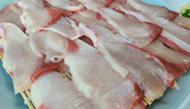“Doing the right thing is things like treating your chickens humanely,” Jim Perdue, the company’s chairman, says in a promotional video. The company’s labels carry a seal of approval from the Department of Agriculture asserting that the bird was “raised cage free,” and sometimes “humanely raised,” although it says it is phasing that one out.
Customers approve. Most of us are meat-eaters who still want animals treated humanely, and one survey found that 85 percent of consumers would prefer to buy chicken with a cage-free “humanely raised” label like Perdue’s.
Enter Craig Watts, 48, a North Carolina farmer who says he raises about 720,000 chickens each year for Perdue. He watched the video of Jim Perdue and had an attack of conscience. “My jaw just dropped,” he said. “It couldn’t get any further from the truth.”
So Watts opened his four chicken barns to show how a Perdue chicken lives. It’s a hellish sight.
Watts invited an animal welfare group, Compassion in World Farming, to document conditions, and it has spent months doing so. The organization has just released the resulting video on its website.
Most shocking is that the bellies of nearly all the chickens have lost their feathers and are raw, angry, red flesh. The entire underside of almost every chicken is a huge, continuous bedsore. As a farmboy who raised small flocks of chickens and geese, I never saw anything like that.
One reason seems to be modern breeding: Chickens are now bred to have huge breasts, and they often end up too heavy for their legs. Poultry Science journal has calculated that if humans grew at the same rate as modern chickens, a human would weigh 660 pounds by the age of eight weeks.
These chickens don’t run around or roost as birds normally do. They stagger a few steps, often on misshapen legs, and then collapse onto the excrement of tens of thousands of previous birds. It is laden with stinging ammonia that seems to eat away at feathers and skin.
I called Perdue to see what the company had to say. Jim Perdue declined to comment, but a company spokeswoman, Julie DeYoung, agreed that undersides of chickens shouldn’t be weeping red. She suggested that the operator was probably mismanaging the chicken house.
That doesn’t go over well with Watts, whose family has owned the farm since the 1700s and says he has been raising chickens for Perdue since 1992, meticulously following its requirements.
As Watts sees it, Perdue realized that consumers were concerned about animal welfare and food safety, and decided to manipulate the public.
The claim about the chickens being raised “cage free” is misleading because birds raised for meat are not in cages. It’s egg-laying chickens that are caged, not the ones we eat. So “cage free” is meaningful for eggs but not for chicken meat. Moreover, Perdue’s chickens are crammed so tightly in barns that they might as well be in cages. Each bird on the Watts farm gets just two-thirds of a square foot.
So why is our government giving its seal of approval to these methods as humane, in ways that seem to mislead consumers?
“U.S.D.A. is the accomplice of Perdue in the fooling of consumers,” says Leah Garces, American director of Compassion in World Farming, who calls it a marketing scam.
Perdue may now be backing away from some of its claims. It settled a suit with the Humane Society of the United States by agreeing to remove the “humanely raised” line from some packaging, even as it denied wrongdoing.
All this leaves millions of Americans, me included, in a bind. We eat meat, yet we want to minimize cruelty to animals. This is an uncertain, inconsistent and perhaps hypocritical path, and it’s hard enough without giant food companies manipulating us . in collusion with our own government.
Garces suggests that such consumers look for labels that say “certified humane”, “global animal partnership” or “animal welfare approved.” But they’re expensive and harder to find.
Perdue’s methods for raising chickens are typical of industrial agriculture. So the conundrum is this. Big Ag has been stunningly successful in producing cheap food . the price of chicken has fallen by three-quarters in real terms since 1930. Yet there are huge external costs, such as antibiotic resistance and water pollution, as well as a routine cruelty that we tolerate only because it is mostly hidden.
Torture a single chicken and you risk arrest. Abuse hundreds of thousands of chickens for their entire lives? That’s agribusiness.
I don’t know where to draw the lines. But when chickens have huge open bedsores on their undersides, I wonder if that isn’t less animal husbandry than animal abuse.
스마터리빙
more [ 건강]
[ 건강]이제 혈관 건강도 챙기자!
[현대해운]우리 눈에 보이지 않기 때문에 혈관 건강을 챙기는 것은 결코 쉽지 않은데요. 여러분은 혈관 건강을 유지하기 위해 어떤 노력을 하시나요?
 [ 건강]
[ 건강]내 몸이 건강해지는 과일궁합
 [ 라이프]
[ 라이프]벌레야 물럿거라! 천연 해충제 만들기
 [ 건강]
[ 건강]혈압 낮추는데 좋은 식품
[현대해운]혈관 건강은 주로 노화가 진행되면서 지켜야 할 문제라고 인식되어 왔습니다. 최근 생활 패턴과 식생활의 변화로 혈관의 노화 진행이 빨라지고
사람·사람들
more많이 본 기사
- 트럼프, 조지아 단속에 “난 바보같이 그렇게 하지 말라고했다”
- 호날두 직접 만난 美 대통령 “아들 앞에서 체면 살아” 농담... 일론 머스크·빈 살만과 함께 ‘백악관 만찬’
- 빈살만 극진환대 트럼프…영부인 만찬 … 1
- 메디케이드·식량·주거 보조 이용… 영… 3
- “미·러 새 종전안, 우크라 영토양보… 1
- ‘엡스타인 파일 연루’ 서머스 전 재무, 오픈AI 이사직 사임
- 아이폰 있으면 국내선 여권 불필요 1
- 실적낸 여성 뉴욕경찰수장, ‘진보’ … 1
- 빅테크도 사우디 투자…xAI·엔비디아, 500㎿ 데이터센터 건설
- 머스크, 백악관 만찬 참석…트럼프 관계회복 본격화되나
- 현빈♥손예진, 최초 부부 동반 남녀주연상..트로피 4개 집으로 [청룡영화상]
- “동양인 비하 제스처, 인종차별 맞다… 1
- “무너진 캘리포니아 재건하겠다” 3
- 中, ‘日수산물 수입 중단’ 추가 보복… “다카이치, 中공분 야기”
- 트럼프, 우크라전 종식 시도 재시동… “러와 28개항 비밀논의”
- “이스라엘, 시리아 철군 요청 거부…안보협상 교착”
- 李대통령, 2박 3일 UAE 국빈 일… 1
- 이이경, ‘AI 사생활 피해’ 실체 밝힐까..결국 “강력 대응” 돌입
- 韓 사상 첫 ‘월드컵 포트2’ 확정, 문제는 ‘포트2답지 못한’ 홍명보호 경기력
- 尹, 취임 반년 뒤부터 ‘비상대권’ 언급…임기내내 계엄 노렸다
- 타일러, ‘스타벅스’ 해프닝 언급→ 마케팅 제안 “내 이름 샌드위치 만들길”[라스]
- 북VA 불법 마사지업소 260곳 넘는다
- BTS 정국도 샤라웃한 올데프 ‘원모어타임’, 해외 차트 상위권 장악
- 신안 해상서 267명 탄 여객선 좌초…3시간여만에 승객 모두 구조
- ‘양평 특혜’ 김건희 오빠 구속영장 기각…법원 “혐의 소명 안돼”
- 한인타운 올림픽·버몬트 총격 사건 1
- 8월 무역 적자 596억 달러…전월 대비 24% 줄어
- JYP의 자부심..스트레이 키즈, 美 폴스타가 뽑은 콘서트 티켓 흥행 수익 2위
- VA 주지사 인수인계 ‘삐걱’…UVA 총장 선임 ‘격돌’
- 아이폰 있으면 국내선 여권 불필요
- 푸드스탬프 수혜자 재신청 절차 요구할 것
- 이젠 프리웨이도 달리는 웨이모
- 美·英·호주, ‘사이버범죄 지원’ 러시아 개인·단체 공동제재
- 검찰 물갈이, 중앙지검장 박철우·반부패 주민철… “안정·쇄신”
- [경제 트렌드] “거스름 줄 동전이 없어”… 1센트 폐지 혼란
- 손흥민, ‘임신 협박 3억 갈취’ 20대女 재판에 ‘증인 출석’... 50분간 비공개 신문
- 한인 마켓도 덮친 ‘대대적 이민 단속… 1
- “소득대비 과도 공제… IRS 감사타겟 될 수도”
- 한인 대형교회 전도사 113만불 횡령… 1
- 사라진 백악관의 이스트 윙
- [화제] 동명이인도 ‘깜짝’ … 스크래치 100만달러 잭팟
- 메디케이드 받으면 영주권 신청 거부된다
- 계속되는 민주당의 헛손질
- 맥도널드, 연말 인기메뉴 ‘맥립’ 출시
- LA 곳곳 ‘폭우 후유증’… 타운도 팟홀 몸살
- AI 확산에 올해 일자리 110만개 사라져
- 고개 숙인 일본, 주머니에 손 넣은 … 4
- 22기 뉴욕평통 출범식⋯“힘찬 출발”
- 김&리 회계법인, 업무협약 체결
- [미국은 지금] 미국 정치의 파산과 그 댓가
1/5지식톡

-
 테슬라 자동차 시트커버 장착
0
테슬라 자동차 시트커버 장착
0테슬라 시트커버, 사놓고 아직 못 씌우셨죠?장착이 생각보다 쉽지 않습니다.20년 경력 전문가에게 맡기세요 — 깔끔하고 딱 맞게 장착해드립니다!장착비용:앞좌석: $40뒷좌석: $60앞·뒷좌석 …
-
 식당용 부탄가스
0
식당용 부탄가스
0식당용 부탄가스 홀세일 합니다 로스앤젤레스 다운타운 픽업 가능 안녕 하세요?강아지 & 고양이 모든 애완동물 / 반려동물 식품 & 모든 애완동물/반려동물 관련 제품들 전문적으로 홀세일/취급하는 회사 입니다 100% …
-
 ACSL 국제 컴퓨터 과학 대회, …
0
ACSL 국제 컴퓨터 과학 대회, …
0웹사이트 : www.eduspot.co.kr 카카오톡 상담하기 : https://pf.kakao.com/_BEQWxb블로그 : https://blog.naver.com/eduspotmain안녕하세요, 에듀스팟입니다…
-
 바디프렌드 안마의자 창고 리퍼브 세…
0
바디프렌드 안마의자 창고 리퍼브 세…
0거의 새제품급 리퍼브 안마의자 대방출 한다고 합니다!8월 23일(토)…24일(일) 단 이틀!특가 판매가Famille: $500 ~ $1,000Falcon: $1,500 ~ $2,500픽업 & 배송직접 픽업 가능LA…
-
 바디프렌드 안마의자 창고 리퍼브 세…
0
바디프렌드 안마의자 창고 리퍼브 세…
0거의 새제품급 리퍼브 안마의자 대방출 한다고 합니다!8월 23일(토)…24일(일) 단 이틀!특가 판매가Famille: $500 ~ $1,000Falcon: $1,500 ~ $2,500픽업 & 배송직접 픽업 가능LA…
케이타운 1번가
오피니언
 정숙희 논설위원
정숙희 논설위원사라진 백악관의 이스트 윙
 파리드 자카리아 워싱턴포스트 칼럼니스트 / CNN ‘GPS’ 호스트
파리드 자카리아 워싱턴포스트 칼럼니스트 / CNN ‘GPS’ 호스트 계속되는 민주당의 헛손질
 김동찬 시민참여센터 대표
김동찬 시민참여센터 대표 [미국은 지금] 미국 정치의 파산과 그 댓가
 성영라 수필가 미주문협 부이사장
성영라 수필가 미주문협 부이사장 [수요 에세이] 부석사, 배흘림기둥에 기대어 보다
 서정명 / 서울경제 논설위원
서정명 / 서울경제 논설위원[만화경] ‘국부론’과 “기업이 곧 국력”
 노세희 부국장대우·사회부장
노세희 부국장대우·사회부장 대한은 다시 살아나는가
 민경훈 논설위원
민경훈 논설위원사자와 생쥐, 그리고 인간 이야기
 한형석 사회부 부장대우
한형석 사회부 부장대우 한인타운 교통 인프라 개선 기대
 박영실 시인·수필가
박영실 시인·수필가 [화요칼럼] 말의 위력
1/3지사별 뉴스

22기 뉴욕평통 출범식⋯“힘찬 출발”
22기 민주평화통일자문회의 뉴욕협의회(회장 이시화)는 17일 퀸즈 플러싱 소재 코리아빌리지 디모스 연회장에서 자문위원 173명을 비롯한 한인사…
메디케이드 받으면 영주권 신청 거부된다

VA 주지사 인수인계 ‘삐걱’…UVA 총장 선임 ‘격돌’
버지니아 글렌 영킨(Glenn Youngkin, 공화, 사진 왼쪽) 주지사와 내년 1월 취임하는 아비가일 스팬버거(Abigail Spanber…
북VA 불법 마사지업소 260곳 넘는다

사우디 빈살만 “1조달러 투자”…7년만의 방미환대 트럼프에 선물
사우디아라비아가 18일 대미 투자액을 기존에 발표했던 6천억 달러(약 876조원)에서 1조 달러(약 1천460조원) 규모로 상향 조정하기로 했…
방한후 美입국했다 석연찮게 구금된 한인과학자, 4개월만에 석방

오늘 하루 이 창 열지 않음 닫기 





















































.png)


댓글 안에 당신의 성숙함도 담아 주세요.
'오늘의 한마디'는 기사에 대하여 자신의 생각을 말하고 남의 생각을 들으며 서로 다양한 의견을 나누는 공간입니다. 그러나 간혹 불건전한 내용을 올리시는 분들이 계셔서 건전한 인터넷문화 정착을 위해 아래와 같은 운영원칙을 적용합니다.
자체 모니터링을 통해 아래에 해당하는 내용이 포함된 댓글이 발견되면 예고없이 삭제 조치를 하겠습니다.
불건전한 댓글을 올리거나, 이름에 비속어 및 상대방의 불쾌감을 주는 단어를 사용, 유명인 또는 특정 일반인을 사칭하는 경우 이용에 대한 차단 제재를 받을 수 있습니다. 차단될 경우, 일주일간 댓글을 달수 없게 됩니다.
명예훼손, 개인정보 유출, 욕설 등 법률에 위반되는 댓글은 관계 법령에 의거 민형사상 처벌을 받을 수 있으니 이용에 주의를 부탁드립니다.
Close
x